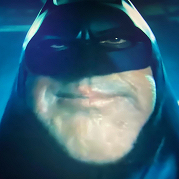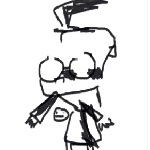|
Franchescanado posted:I changed the thread title, because the previous one--"Philosophy of Movies"--was misleading. This thread is discussing plot holes and flawed logic vs common sense, and had nothing to do with Philosophy.
|
|
|
|

|
| # ? Apr 29, 2024 13:34 |
|
Martman posted:Is it still the same thread now? Or is it a nearly identical clone? 
|
|
|
|
Lol forums cancer still exists?
|
|
|
|
i like this peek behind the curtain
|
|
|
|
JfishPirate posted:Either toys are naturally animated (in the same way that any other living being is, through DNA replication) or imbued with life by some sort of outside force, such as magic. Let's look at the facts: The new trailer has a scene where a cat disembowels a toy and it made me think of this post. How would a pet's toy function under this theory? Does the pet toy have the same desire to entertain its human master (like some zealous gladiator who is happy to be torn by lions to bring a smile to Caesar's face) or are pet toys bound instead to their animal's-masters, in which case there ultimate desire is fundamentally sadomasochistic, to be destroyed, even if no human is present to amuse themselves at the spectacle. I'd argue for the first option, because it doesn't seem that animals can imbue inanimate,organic objects with life, if that were the case various objects that cats pursue would skitter around like mice in the absence of animals.
|
|
|
|
crowoutofcontext posted:The new trailer has a scene where a cat disembowels a toy and it made me think of this post. I believe the first is correct. If a human creates a toy for a pet (handmade/factory), that human has imbued it with life. The toy may be intended for pets only, but the toy is still alive by the virtue of the human-derived energy. It is apparent in the scene from the trailer that the toy attacked by the cat is 'dead', which indicates damage can be severe enough to a toy to release the captured lifeforce. I would definitely agree that toys do not seek to serve animal masters, as they seem to place a special status on the attention given by a human (even in a museum setting, like Stinky Pete). However, it is odd to contemplate the 'zealous gladiator' interpretation of pet toys, as pets are far more harsh than even humans in their infancy, and the toys in TS3 did not greatly appreciate being played with by the careless toddlers. Fundamentally, toys do not know their purpose until they are first played with or are told by another toy. Pet toy society seems to be far less developed than human toy society, and it may be that pet toys are simply never given the opportunity to experience the rapturous joy of the Creator, or even learn that this is their supposed purpose. An important piece of this puzzle is the short film Toy Story that Time Forgot. The Battlesaurs are very militaristic, and the wizard dinosaur calls the child's name on the bottom of Trixie's foot "the mark of obedience" with disdain. The main dinosaur, Reptillius, eventually cedes to Trixie's thinking that toys are bound to play with their masters, with his epiphany being that he must 'surrender' to be true to his nature as a toy. The short ends with Reptillius in post-playtime glow, proclaiming the playtime he once eschewed as 'glorious'. There is a heavy religious undertone to the way Trixie proselytizes to Reptillius, as most of her dialogue is her spreading the good word of submission to the Creator. The message of the film is that to be played with is to literally touch God, and that all those who defy this order are simply wrong. It may be, then, that the power is not necromantic, but divine. Humans are created in the image of God, and their primary purpose on Earth is to serve His will. Toys are just simulacra of the same process at a smaller scale. God does not recognize individual humans, and neither do humans recognize the sentience of toys. The scene from the newest trailer that is most interesting to me is not the disemboweling one, however. Towards the end of the trailer, two toys from the carnival games attack an elderly woman, yelling at her to surrender a set of keys. This is a far more blatant display of anima and extremely aggressive behavior than anything we have seen from a toy in the previous films. Sid was threatened, but not really assaulted. Even for a cruel Creator like Sid, Woody's message was ultimately for him to 'play nice'. He respected his status as Creator even when it was a life-or-death situation. The two carnival game toys have gone rogue in a way that was unthinkable to even Stinky Pete, and seem to represent a sea change in the way some toys interact with their overlords. The Battlesaur wizard was anti-play and anti-obedience, but not necessarily anti-Creator, similar but not identical to Stinky Pete. The two carnival game toys, in contrast, have desires that are so strong they are willing to attack the Creators to accomplish them. I believe we have seen the first true radicals in the toy world. To strike against God is to commit the most grievous sin, and I hope we get to see how this Creator, elderly and feeble as she is, react to this desperate act.
|
|
|
|
the toys hang out with buster apparently for an entire decade and buster seems to treat woody like a dog treats a human more than anything. Like woody orders buster to do things but like a person who had trained a dog would.
|
|
|
|
https://www.youtube.com/watch?v=pj4p3_us28Y
|
|
|
|

|
| # ? Apr 29, 2024 13:34 |
|
Re: wizard economy, I just figure that making things that are or that do magic can't be done instantly with a simple spell, so there's an economy for magic stuff even if mundane things are effectively post-scarcity. Examples would be how nobody ever just magically copies up a second wand even when they could really use one, and how the Weasleys are described as penny-pinchingly poor but have a massive home and enough spare dosh for feasts and for Arthur to screw around with big hobby projects. This also explains why all the magic food being sold is animated or has magic flavors or whatever: none of the wizard companies make just plain chocolate because there'd be zero profit from it.
|
|
|













